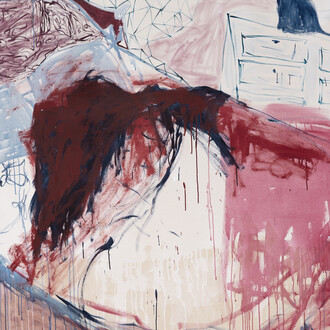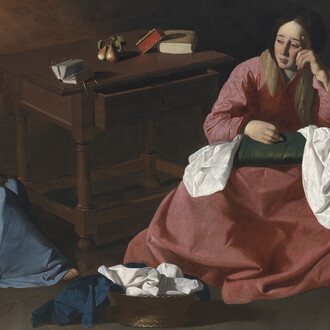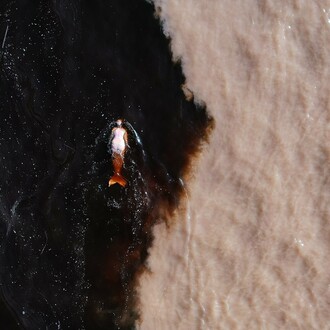Gala Porras-Kim’s research-driven practice examines how museological choices and conventions surrounding collecting, taxonomy, preservation and display shape our understandings of cultural artefacts. Monika Sprüth and Philomene Magers are pleased to present The categorical bind, a solo exhibition featuring new and recent works by the artist on the occasion of London Gallery Weekend. Both visually striking and thought-provoking, Porras-Kim’s drawings, paper marbling works and sculpture explore the transformation—and possibly emancipation—of objects throughout time.
The exhibition highlights the relationship between objects created through contemporary subjective choices within institutional processes and the multiplying functions that historical objects accumulate when collected. The works on view challenge notions of categorisation, highlighting how institutions often reinforce singularities over pluralities. The categorical bind reconsiders these restrictive taxonomical approaches, assumptions and definitions—remnants from the origins of scientific collection and cataloguing. Establishing parallels between cataloguing and the process of art-making, both of which grapple with how to define material in the world, the show spotlights the shared complexities of authorship inherent in these practices.
Drawing constitutes a fundamental aspect of Porras-Kim’s practice, wherein her intricately detailed images serve as a way to examine and reconsider historical objects and their contexts. On the gallery’s ground floor hang two colour pencil drawings depicting marble tiles in Ravenna, Italy. The large-scale works San Vitale, Ravenna, marble floor reconstruction (both 2025) show portions of the church of San Vitale’s marble floor, which contain generations of conservation interventions. Performing a close reading of uncatalogued histories, Porras-Kim brings to light the signs of conservation and restoration efforts embedded within its surface. Using a medium that is itself inherently subjective and resistant to mechanical reproduction, these works challenge the notion of historical accuracy. By recording the visible layers of time, the drawings emphasise how histories are shaped by intervention, subject to inevitable decay, and perpetually open to reinterpretation.
Displayed on the adjacent walls are two of what the artist refers to as ‘index drawings’, in which she presents collections of historical objects arranged on imaginary shelves. The drawings on view delve into the holdings of the Carnegie in Pittsburgh, an institution that over time was subdivided into several institutions, among them Carnegie Museum of Natural History and Carnegie Museum of Art. 51 snuff boxes at Carnegie Museum of Art (2025) presents snuff boxes whose function changed upon their transfer to the art museum, fundamentally altering the context in which they are read. In the diptych 69 containers at Carnegie Museum of Art or at Carnegie Museum of Natural History (2025), the artist portrays vessels which are divided by their categorisation into the respective collections. These images challenge the distinctions made between ‘art’ and ‘object’, revealing how bound these definitions are to the spaces that exhibit them.
A terminal escape from the place that binds us (2025) addresses a different aspect of museological transformation. Here, Porras-Kim considers the afterlife of two- thousand-year-old human remains held by the Gwangju National Museum in South Korea. In a letter to the museum’s director, she calls into question at what point the agency over one’s body ceases. Accompanying the letter is a large-scale work where marbled paper constitutes an image of a location—a topographical landscape of vivid pigment swirls, suggesting an alternative, self-determined final resting place. A refreshing approach to institutional critique, the work questions the colonial ideology behind the encyclopaedic museum and proposes nuanced ways of representing the ancient past.
Upstairs, Porras-Kim delves into the collection of Oxford University’s Pitt Rivers Museum, one of the first to introduce typology to anthropology and archaeology, grouping materials according to perceived formal or functional similarities, rather than by their place of origin. Examining the museum’s forms of display, these drawings portray singular display structures that contain new institutional compositions. 1 Vitrine C.122. A side A with 23 Treatment of the Dead objects at Pitt Rivers Museum and 1 Vitrine C.122. A side B with 41 Treatment of the Dead objects at Pitt Rivers Museum (both 2025) depict two sides of the same showcase, which until very recently held human remains, and still houses burial objects that were intended to actively perform a role in an individual’s afterlife. These works illuminate the friction between the indefinite function of the objects for the deceased and their current position within the composition of the vitrine.
Five smaller drawings concern themselves with collection drawers, which previously served as ‘overspill’ storage for items from the Pitt Rivers that are now accessible to visitors. The displayed artefacts are secured in foam cutouts that place them within a composition. 1 Drawer C.61.14 with 2 Amulets, Charms and Religious & Divination Artefacts & House Ornaments - Asia at Pitt Rivers Museum (2025) depicts two amulets bound at their necks, arms, waists and feet by black bows, securing them within their storage drawer. The remarkable image visually represents the constraints imposed upon these objects, inviting viewers to contemplate their original purpose.
Nearby, the work All Earth energy sources are known to come from the sun (2025) engages with the specifics of the gallery’s architecture: a rectangular brass sheet, designed in proportion to the gallery window and erected at a specific angle, reflects sunlight onto an adjacent wall, creating a bright, brilliant and ephemeral beam of light, which slowly burns a drawing onto the wall. Playing with themes of conservation and destruction, the structure is activated by a natural element beyond the artist’s control. Finally, a graphite drawing, Burial chamber scene (2025), proposes a view from inside a grave. The enveloping darkness of the work describes an unperceivable location that alludes to an unknowable depth to our cultural heritage, which, despite advancements in research techniques and technological innovations, eludes our full understanding. Together, the works point towards both the illuminating moments and shadowed corners of museum knowledge systems. Porras-Kim reveals that the artefacts we preserve and display carry multiple, additive functions that transcend the confines of conventional classification.
















